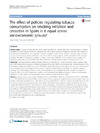Identificador persistente para citar o vincular este elemento:
https://accedacris.ulpgc.es/jspui/handle/10553/51252
| Campo DC | Valor | idioma |
|---|---|---|
| dc.contributor.author | Pinilla, Jaime | en_US |
| dc.contributor.author | Abásolo, Ignacio | en_US |
| dc.date.accessioned | 2018-11-24T22:52:19Z | - |
| dc.date.available | 2018-11-24T22:52:19Z | - |
| dc.date.issued | 2017 | en_US |
| dc.identifier.issn | 1617-9625 | en_US |
| dc.identifier.other | WoS | - |
| dc.identifier.uri | https://accedacris.ulpgc.es/handle/10553/51252 | - |
| dc.description.abstract | Background: In Spain, the Law 28/2005, which came into effect on January 2006, was a turning point in smoking regulation and prevention, serving as a guarantee for the progress of future strategies in the direction marked by international organizations. It is expected that this regulatory policy should benefit relatively more to lower socioeconomic groups, thus contributing to a reduction in socioeconomic health inequalities. This research analyzes the effect of tobacco regulation in Spain, under Law 28/2005, on the initiation and cessation of tobacco consumption, and whether this effect has been unequal across distinct socioeconomic levels.Methods: Micro-data from the National Health Survey in its 2006 and 2011 editions are used (study numbers: 4382 and 5389 respectively; inventory of statistical operations (ISO) code: 54009), with a sample size of approximately 24,000 households divided into 2,000 census areas. This allows individuals' tobacco consumption records to be reconstructed over five years before the initiation of each survey, as well as identifying those individuals that started or stopped smoking. The methodology is based on "time to event analysis". Cox's proportional hazard models are adapted to show the effects of a set of explanatory variables on the conditional probability of change in tobacco consumption: initiation as a daily smoker by young people or the cessation of daily smoking by adults.Results: Initiation rates among young people went from 25% (95% confidence interval (CI), 23-27) to 19% (95% CI, 17-21) following the implementation of the Law, and the change in cessation rates among smokers was even greater, with rates increasing from 12% (95% CI, 11-13) to 20% (95% CI, 19-21). However, this effect has not been equal by socioeconomic groups as shown by relative risks. Before the regulation policy, social class was not a statistically significant factor in the initiation of daily smoking (p > 0.05); however, following the implementation of the Law, young people belonging to social classes IV-V and VI had a relative risk of starting smoking 63% (p = 0.03) and 82% (p = 0.02) higher than young people of higher social classes I-II. On the other hand, lower social class also means a lower probability of smoking cessation; however, the relative risk of cessation for a smoker belonging to a household of social class VI (compared to classes I-II) went from 24% (p < 0.001) lower before the Law to 33% (p < 0.001) lower following the law's implementation.Conclusion: Law 28/2005 has been effective, as after its promulgation there has been a decrease in the rate of smoking initiation among young people and an increase in the rate of cessation among adult smokers. However, this effect has not been equal by socioeconomic groups, favoring relatively more to those individuals belonging to higher social classes. | en_US |
| dc.language | eng | en_US |
| dc.relation.ispartof | Tobacco Induced Diseases | en_US |
| dc.source | Tobacco Induced Diseases [ISSN 1617-9625], v. 15 (8), (Enero 2017) | en_US |
| dc.subject | 531207 Sanidad | en_US |
| dc.subject.other | Tobacco Regulation | en_US |
| dc.subject.other | Socioeconomic Groups | en_US |
| dc.subject.other | Smoking Initiation And Cessation | en_US |
| dc.subject.other | Smoking Bans | en_US |
| dc.subject.other | National Health Survey | en_US |
| dc.subject.other | Spain | en_US |
| dc.title | The effect of policies regulating tobacco consumption on smoking initiation and cessation in Spain: is it equal across socioeconomic groups? | en_US |
| dc.type | info:eu-repo/semantics/article | en_US |
| dc.type | Article | en_US |
| dc.identifier.doi | 10.1186/s12971-016-0109-4 | en_US |
| dc.identifier.scopus | 85010977109 | - |
| dc.identifier.isi | 000392997600001 | - |
| dc.contributor.authorscopusid | 7005595836 | - |
| dc.contributor.authorscopusid | 57188770543 | - |
| dc.identifier.issue | 8 | - |
| dc.relation.volume | 15 | en_US |
| dc.investigacion | Ciencias Sociales y Jurídicas | en_US |
| dc.type2 | Artículo | en_US |
| dc.contributor.daisngid | 1717005 | - |
| dc.contributor.daisngid | 2369703 | - |
| dc.description.numberofpages | 10 | en_US |
| dc.utils.revision | Sí | en_US |
| dc.contributor.wosstandard | WOS:Pinilla, J | - |
| dc.contributor.wosstandard | WOS:Abasolo, I | - |
| dc.date.coverdate | Enero 2017 | en_US |
| dc.identifier.ulpgc | Sí | en_US |
| dc.contributor.buulpgc | BU-ECO | en_US |
| dc.description.sjr | 0,716 | |
| dc.description.jcr | 1,539 | |
| dc.description.sjrq | Q1 | |
| dc.description.jcrq | Q3 | |
| dc.description.scie | SCIE | |
| dc.description.ssci | SSCI | |
| item.grantfulltext | open | - |
| item.fulltext | Con texto completo | - |
| crisitem.author.dept | GIR Economía de la salud y políticas públicas | - |
| crisitem.author.dept | Departamento de Métodos Cuantitativos en Economía y Gestión | - |
| crisitem.author.orcid | 0000-0002-7126-4236 | - |
| crisitem.author.parentorg | Departamento de Métodos Cuantitativos en Economía y Gestión | - |
| crisitem.author.fullName | Pinilla Domínguez, Jaime | - |
| Colección: | Artículos | |
Citas SCOPUSTM
17
actualizado el 08-jun-2025
Citas de WEB OF SCIENCETM
Citations
18
actualizado el 08-jun-2025
Visitas
150
actualizado el 28-sep-2024
Descargas
95
actualizado el 28-sep-2024
Google ScholarTM
Verifica
Altmetric
Comparte
Exporta metadatos
Los elementos en ULPGC accedaCRIS están protegidos por derechos de autor con todos los derechos reservados, a menos que se indique lo contrario.
